In antiquity athletes assembled at the altar in front of the Temple of Zeus where they performed sacrifices and swore their oath. Because the area between the temple and the stadium, which is about 400 meters distant, has not been excavated, we cannot reproduce this aspect of the ancient games. Instead, all the athletes will assemble at the ancient locker room (apodyterion) which lies just outside the stadium where they will be assigned to their final grouping of twelve for each race — each group of similar age and the same gender.
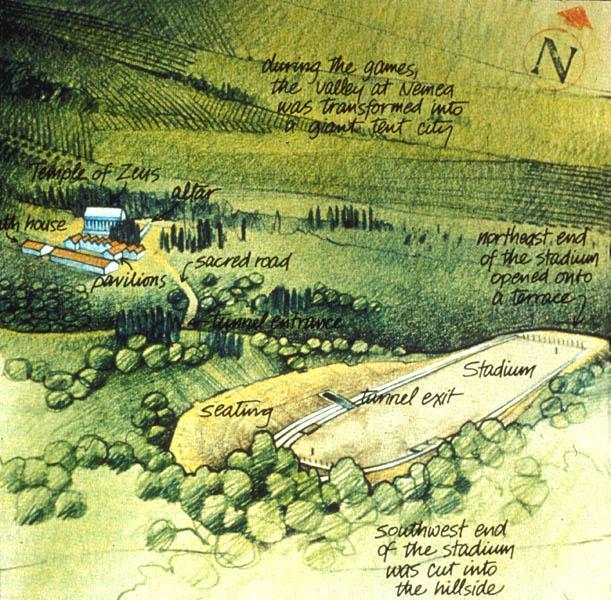
Drawing showing the relationship between the Sanctuary of Nemean Zeus and the Stadium with the Sacred Road that connected them.
The locker room (apodyterion) is located just inside the entrance to the stadium park. It was constructed about 300 B.C. with a central courtyard surrounded on three sides by Doric colonnades. For the modern games, this building is covered by a large modern tent that is exactly the same size as the ancient building (13.50 m. x 16 m. x 5 m.).
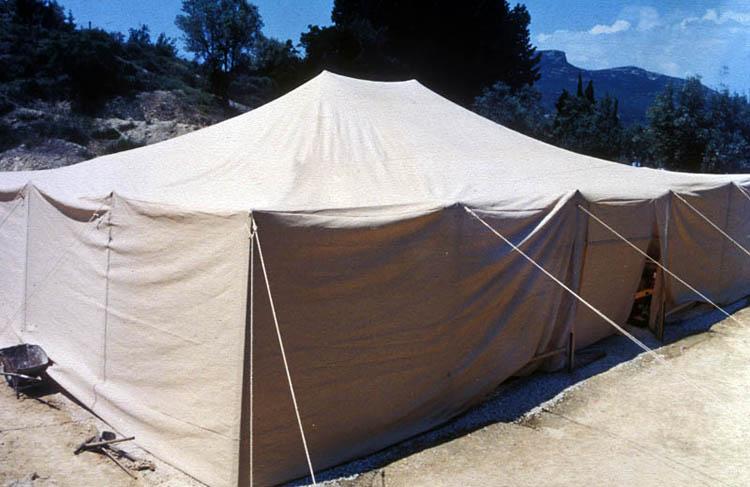
Tent erected over the ancient locker room.
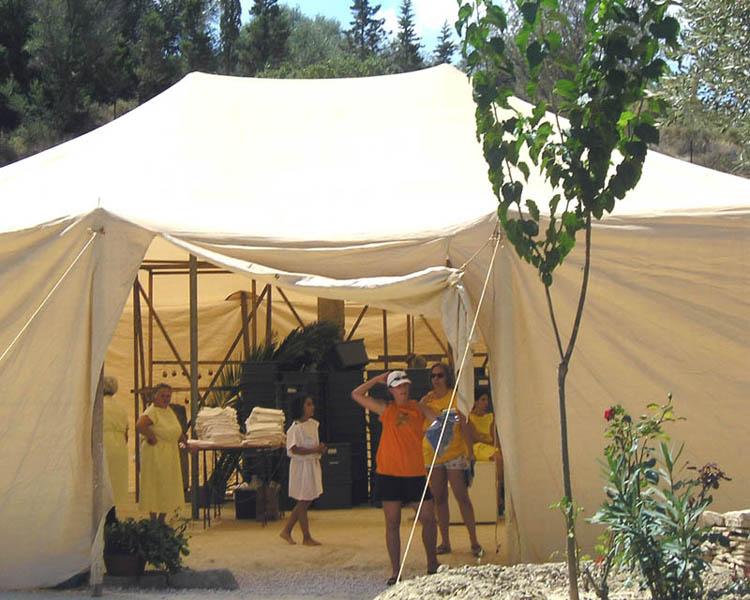
View into the tent where scaffolding protects the ancient columns.
Once inside the tent, the athlete is with the ancient columns surrounded by scaffolding from which will be suspended small clay jars (aryballoi) which are round and about the size of a tennis ball with a small hole on one side. These aryballoi contain olive oil as they did in antiquity — for the athletes to rub over their bodies. The purpose of the oil is not known; it was perhaps a lotion to protect against the sun, perhaps a means of warming muscles, perhaps an aesthetic addition to the appearance of the athlete. Modern athletes who have used the oil remark that it increases liquid retention and, thereby, stamina.
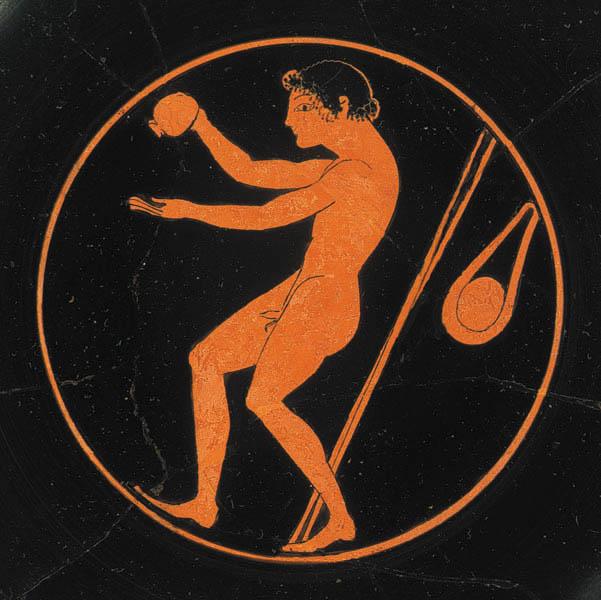
Athlete pours oil from an aryballos onto the palm of his hand. Red-figure tondo, ca. 510 B.C.

Modern aryballoi suspended from scaffolding in the locker room.
The modern participant at the Nemean is not required to use the oil, nor to compete in the nude — although that would be authentic. Rather, when each competitor enters the apodyterion tent, he or she is given a large bag, a chiton (tunic), and a zoni (belt). The competitor removes shoes and socks, and whatever clothes desired, and places them in the bag being sure to retain the number/label which is pinned on the chiton. A doulos (slave — in a yellow chiton) will take the bag for safe-keeping. The chiton slips over the head, and the zoni tightened around the waist will allow the length of the chiton to be adjusted to suit. Most people are most comfortable with it slightly above knee height.
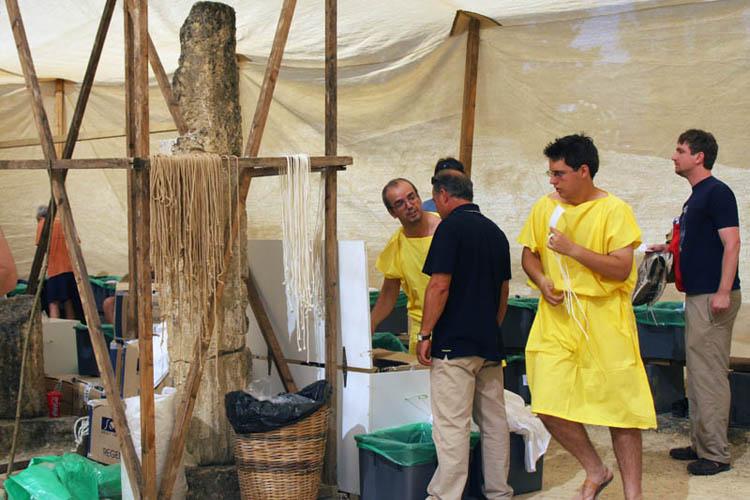
Slaves (in yellow) hand chitons to runners in the locker room.
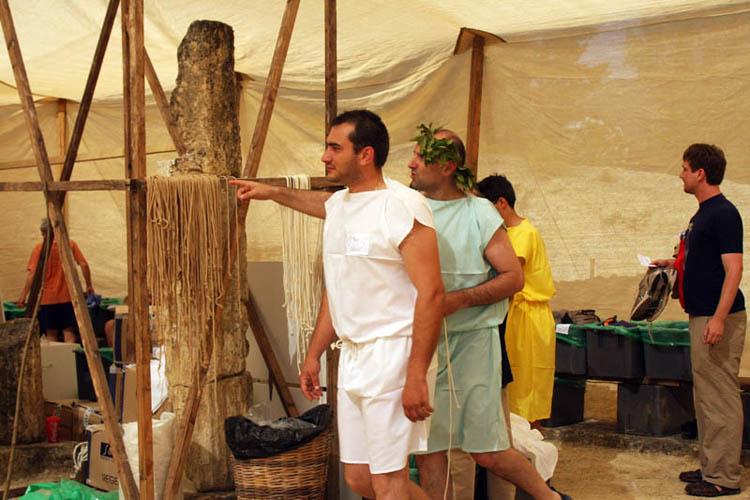
Chiton-clad runner is instructed to exit the the locker room for the tunnel.
A Hellanodikes (judge) enters the tent when it is time for the next group of runners. He will be dressed in a black himation (long robe) as were the judges at the ancient Nemean Games in memory of the death of Opheltes, and he will be holding a switch made from the vitex shrub with which he will flog anyone who commits a foul or does not obey his orders — as was done in ancient Greece. The Hellanodikes summons the next group to leave the apodyterion and enter the passageway between it and the krypte esodos (hidden entrance tunnel). There he administers the oath of the Nemean Games in Greek:
“Do you swear to abide by the rules of the Nemean Games and to do nothing that would bring shame to you, your family, or the spirit of the ancient Games?”
Each participant is expected to respond: “I swear.” And the judge will respond, as he did in antiquity: “Now go forward into the stadium, and be worthy of victory.”
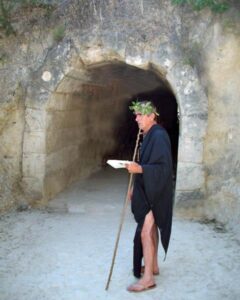
Judge delivers the oath.
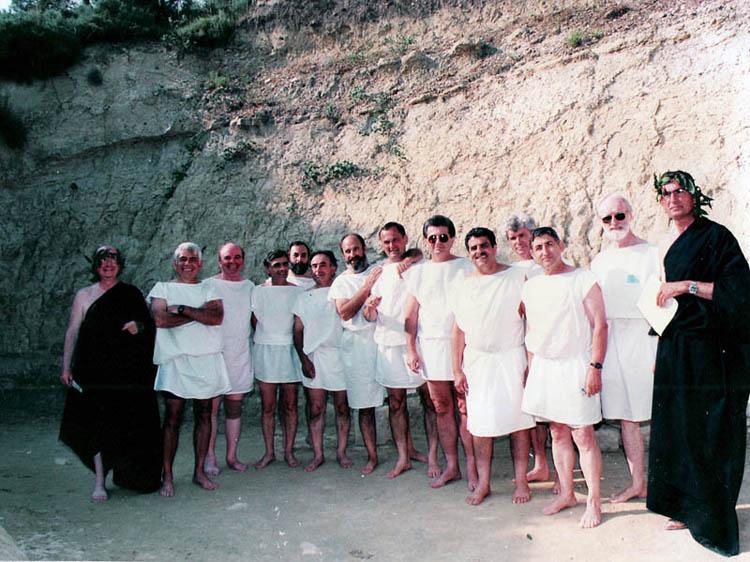
Judges with group of athletes about to enter the tunnel.
Now the participant passes through the 120′ long ancient tunnel (constructed about 2,320 years ago) being careful not to touch the walls, for the graffiti scratched then by ancient athletes can be damaged. At the far end of the tunnel, the participants wait for a blast from the salpinktes (trumpeter, dressed in a maroon chlamys) that signals the crowd to be quiet. Next the keryx (herald, in a blue himation) calls out the name of each athlete.
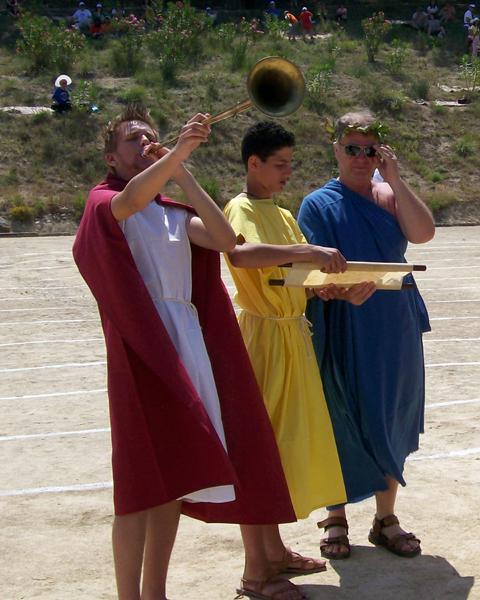
Salpinktes calls for silence so that herald can read the names of the athletes from list held by the slave.
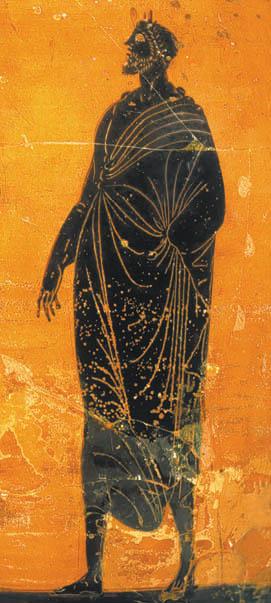
Himation-clad herald, Panathenaic amphora, 340/39 B.C.
When the keryx calls his or her name, the participant runs out of the tunnel to the track, and turns right to run to the starting line (balbis) at the end of the track. When the whole group is there, another hellanodikes asks each participant to draw a kleros (marble lot) from a bronze helmet. (At Olympia, the kleroi inscribed with letters were about the size of beans, and were drawn from a silver pitcher.)
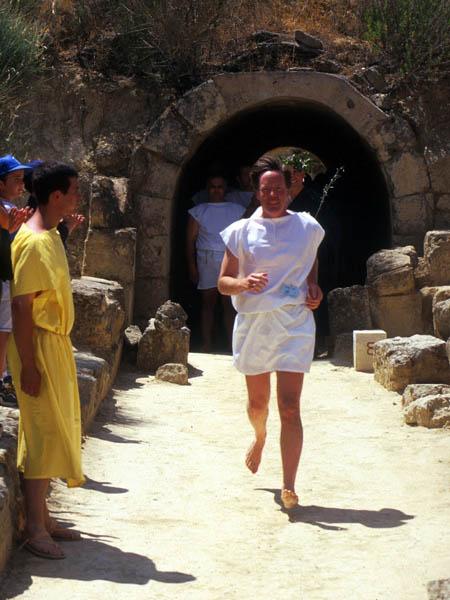
Athlete enters the stadium from the tunnel.
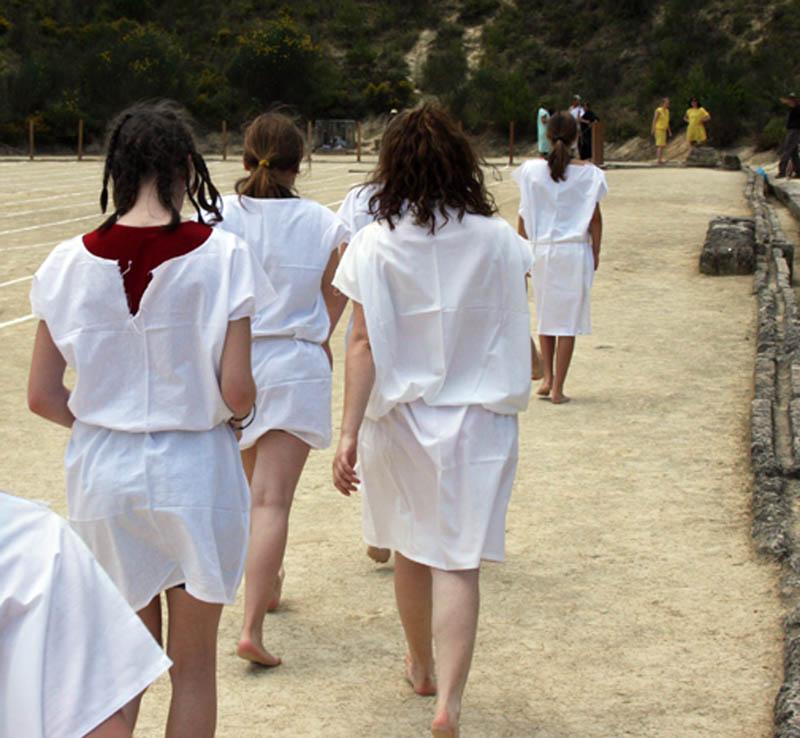
Athletes who have entered the stadium turn toward the starting line.
There are six pairs of lanes marked on the track, and six pairs of kleroi. The lanes and the kleroi are marked A (alpha), B (beta), G (gamma), D (delta), E (epsilon), and Z (zeta). The 12 competitors in each group will run straight down the track for 90 m. to the finish line. This is the race called the stadion although the ancient stadion race was actually twice as long, but the Nemean stadium track is not preserved to the full ancient length. There will be one competitor in each lane with the pairs (of alphas, betas, etc.) deciding between themselves who will take the right and who the left lane of the pair.
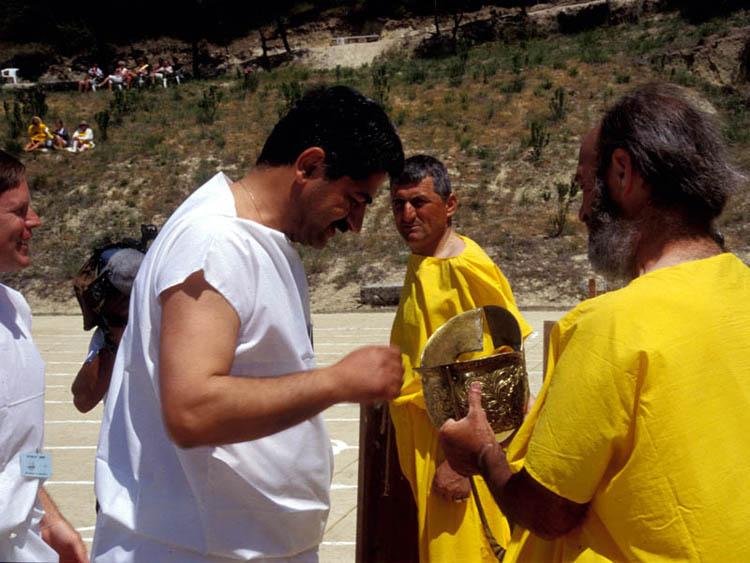
Athlete draws lot from helmet held by slave.
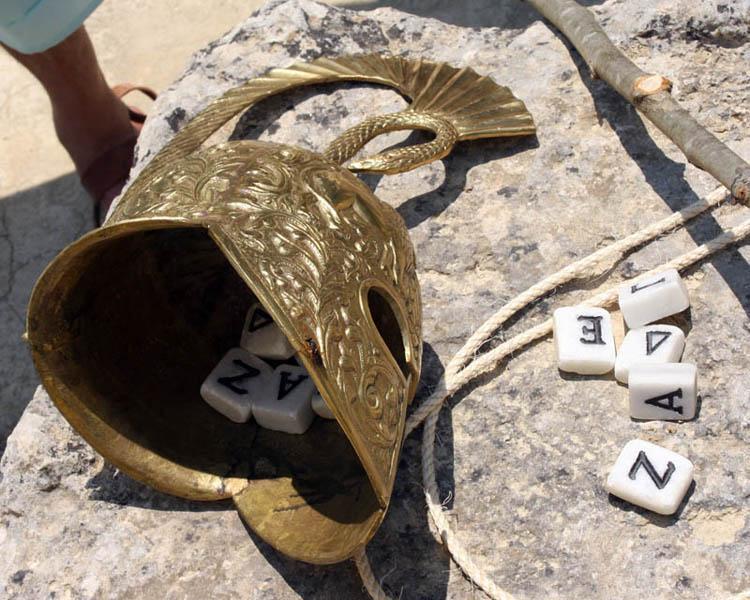
Helmet with marble lots.
With the lanes assigned, each modern athlete positions him-/herself with the toes of one foot in the front groove and the toes of the other foot in the back groove. The toes should be curled to gain purchase over the ancient stone just as the ancient toes were curled. It does not matter which foot is forward and which behind, but most right-handed people feel more comfortable with the left foot advanced, most left-handed people with the right foot. But BOTH FEET MUST BE IN THE GROOVES. This was a part of the effort to insure an absolutely equal start in antiquity. If both feet are not in the grooves the switch of the Hellanodikes will be felt.
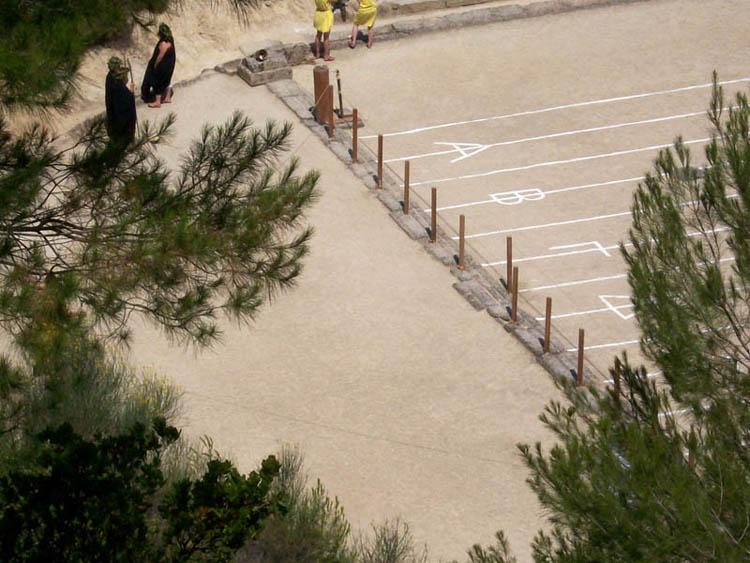
Lanes marked on floor of stadium with lime and on starting line by posts.
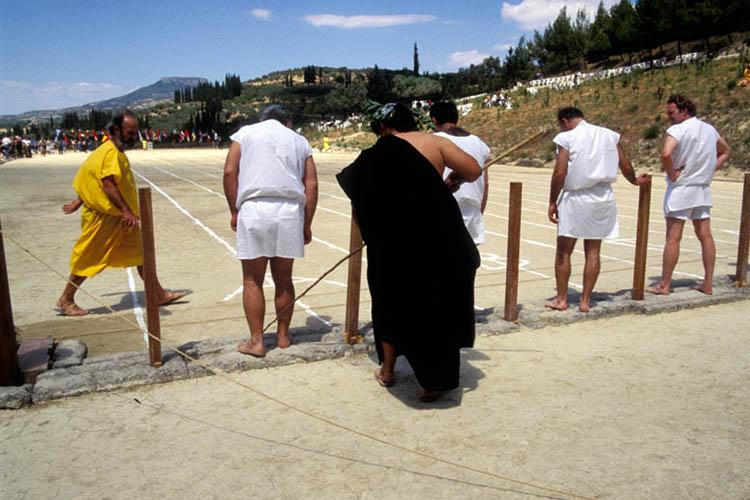
Judge “encourages’ athletes’ feet into grooves.
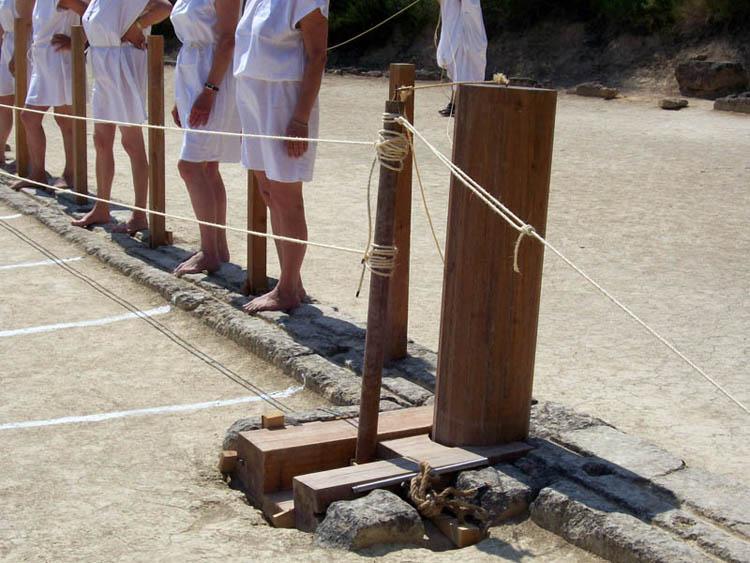
Toes in the grooves, starting mechanism cocked.
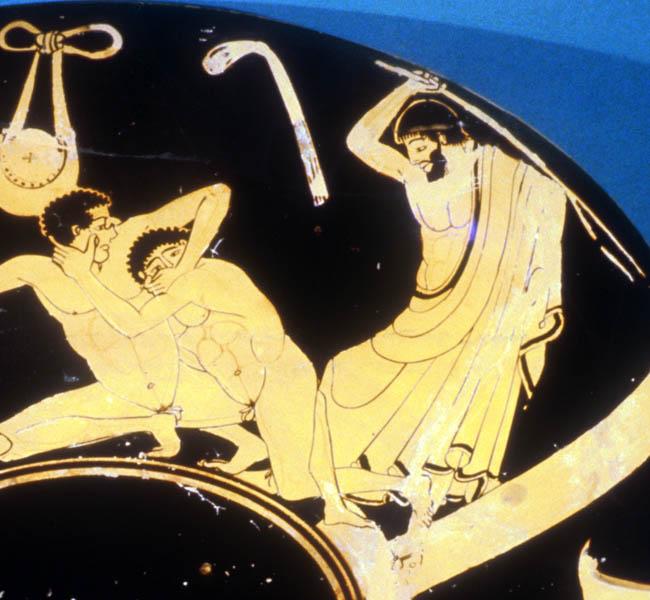
Judge flogs errant athlete. Red-figure kylix, ca. 490 B.C.
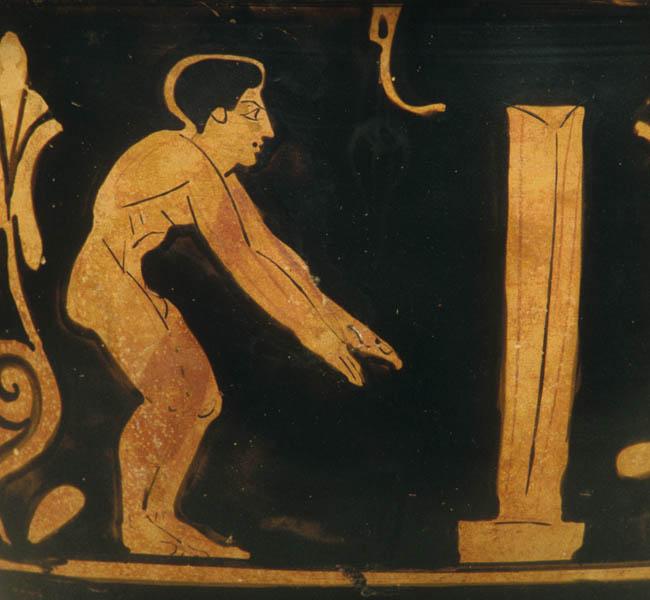
Athlete in the starting position, red-figure krater, ca. 400 B.C.
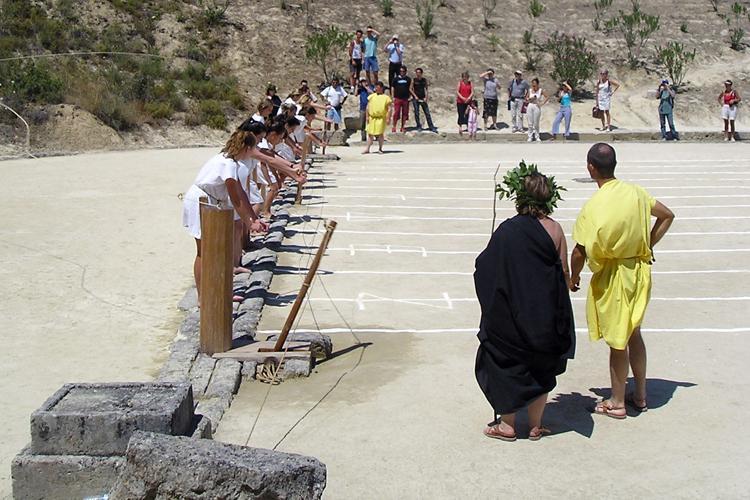
Modern runners in the starting position.
The starting stance is upright and leaning forward with arms outstretched like a diver. They will be over the top of two barrier-cords stretched parallel to the balbis in front of all the runners. These cords are attached to a post at either end of the balbis that is a part of the hysplex (starting machine) which introduces torsion on the post by means of twisted ropes in a heavy wooden frame. (The principle was adapted from the catapult in the 4th century B.C.) This post is cocked in an upright position.
When all the runners have taken their positions, and the aphetes (starter, in a white himation) has prepared the hysplex to his satisfaction, the salpinktes will blow his trumpet, and the aphetes will shout out three ancient words which are the rough equivalent of our English “ready! set! GO!”
“poda para poda” (foot by foot)
“ettime” (ready)
“apite” (GO)
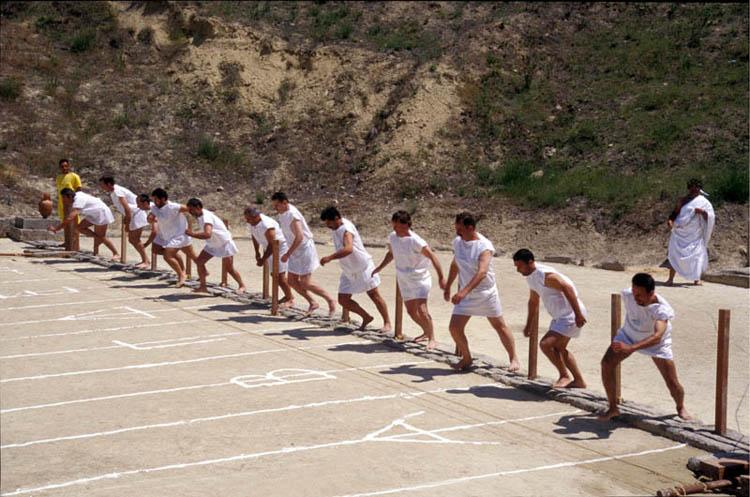
The runners are off . . . .
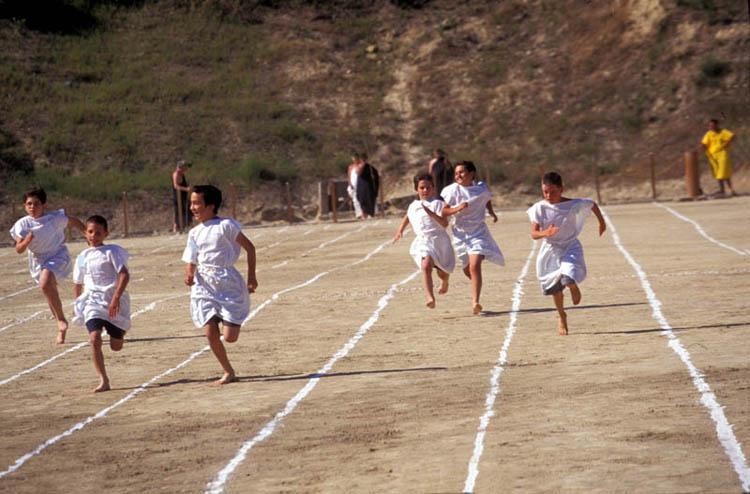
. . . . down the track.
As he shouts APITE the aphetes pulls the trip-cords which release the hysplex and the torsion-loaded post hurls the barrier-cords to the ground in front of the runners. Unless one starts too early, gets tangled in the barrier-cords, and is flogged, and the race has to begin over, all the runners sprint straight down the track.
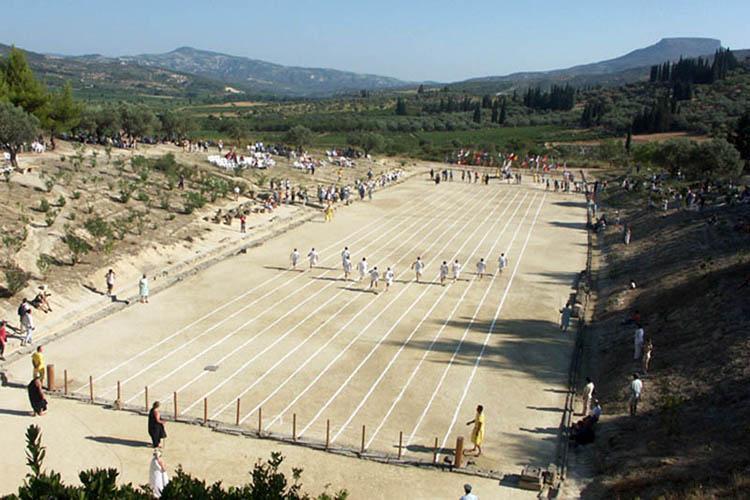
The Hellanodikai at the finish line tie a ribbon around the head of the victor, and give him/her a palm branch. These were the immediate tokens of victory that were awarded in antiquity. The salpinktes will blow his trumpet, and the keryx will announce the name of the victor. (The winner should wear the ribbon and keep the palm branch close at hand for the rest of the Games.)
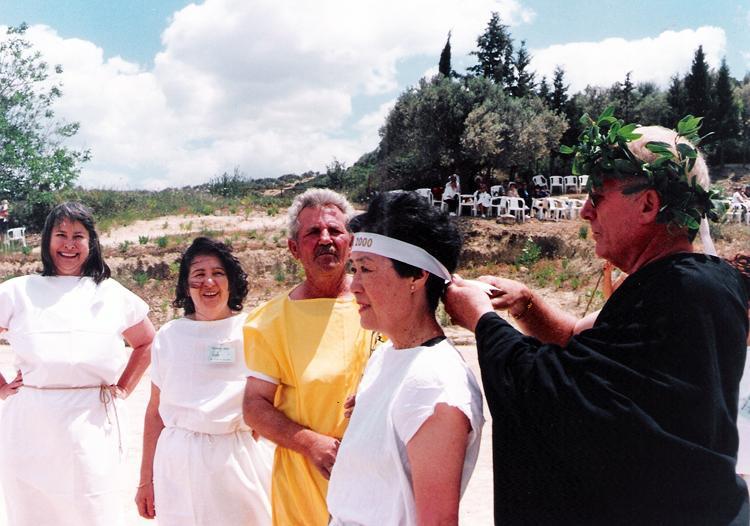
Tying the ribbon on the winner.
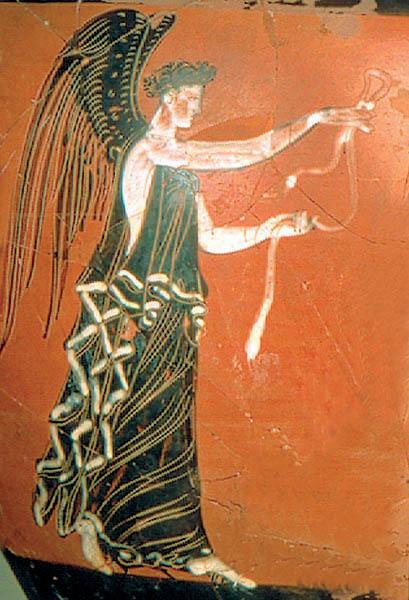
Nike offers ribbon. Panathenaic amphora, 363/2 B.C.
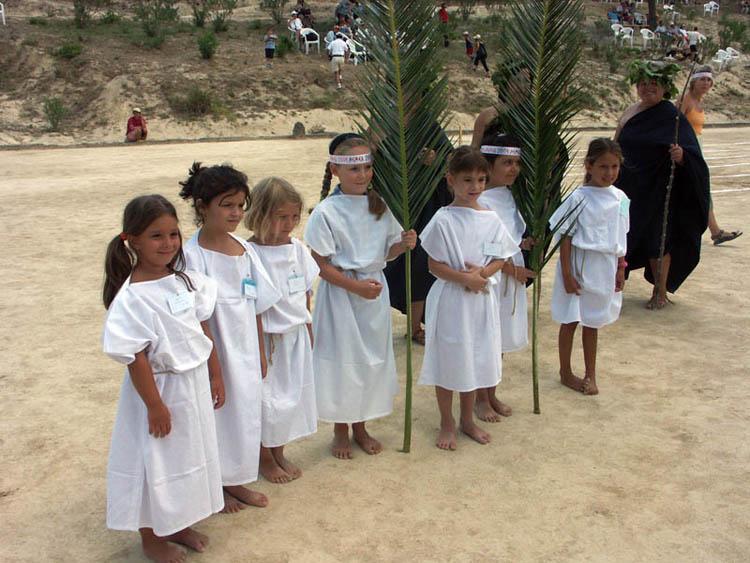
Double victors with ribbons and palms
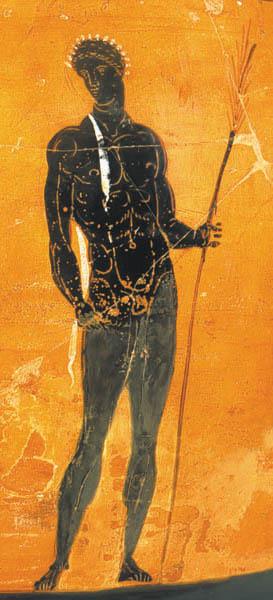
Victor with ribbon and palm, Panathenaic amphora, 340/39 B.C.
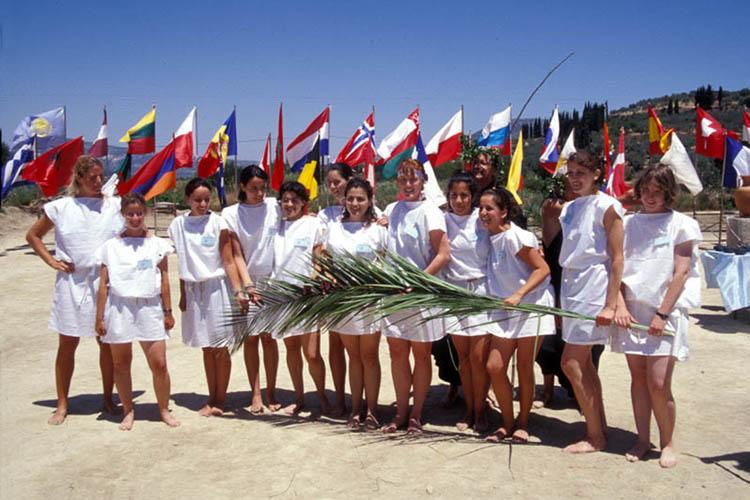
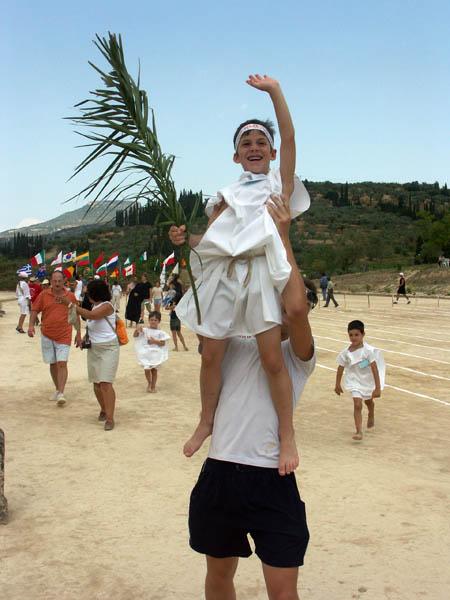
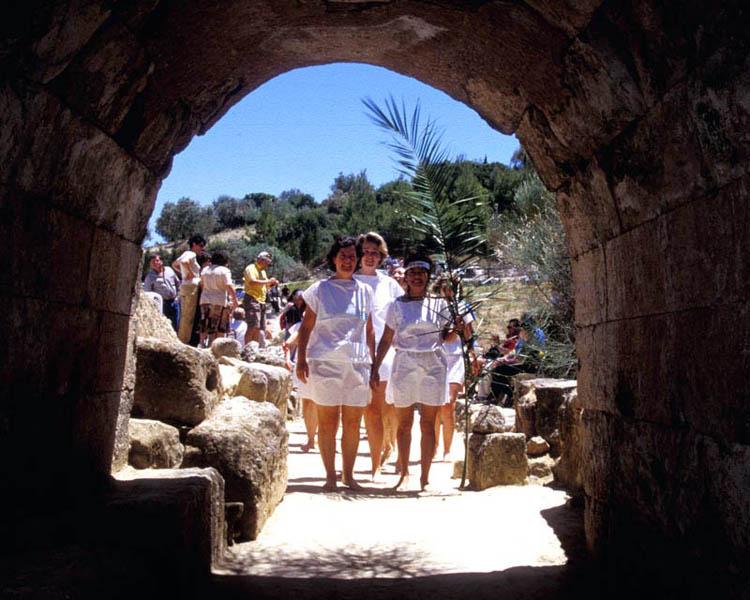
Returning through the tunnel.
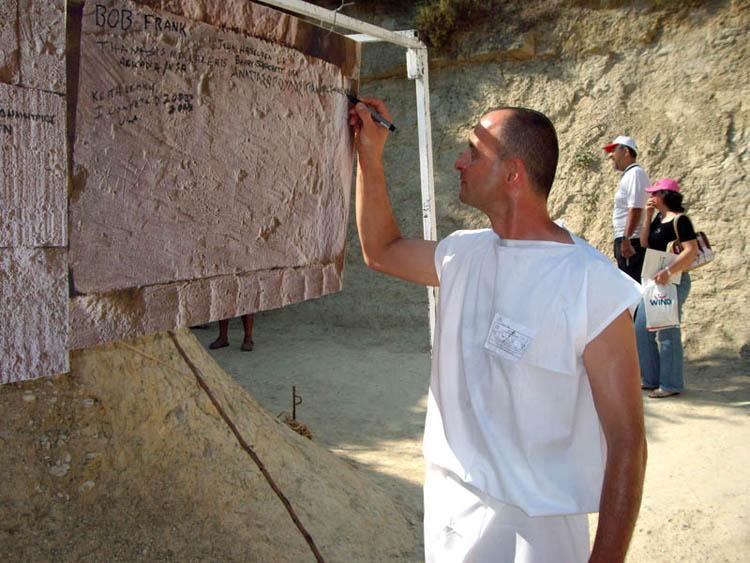
Modern graffito on photo of ancient wall.
The runners now return through the krypte esodos to the apodyterion. Just outside the apodyterion are full-scale photographs of the ancient tunnel wall including some of the ancient graffiti. Each participant is invited to add his/her own autograph to the photographs. These modern graffiti become a part of the permanent record of the modern Nemeads.
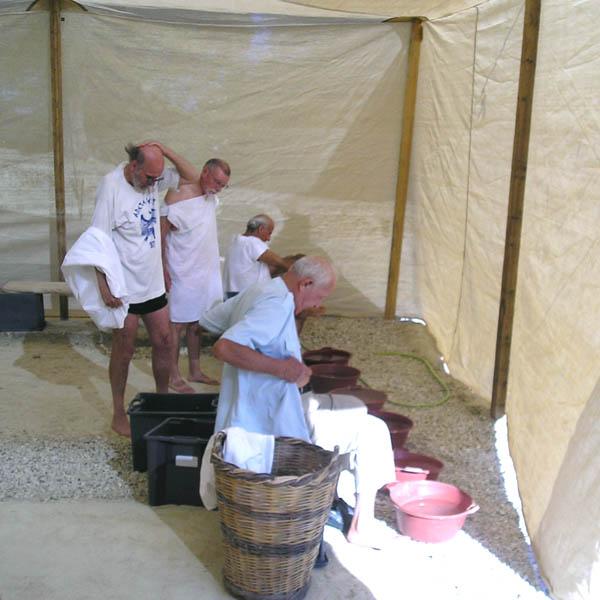
Washing feet in the locker room and returning to today.
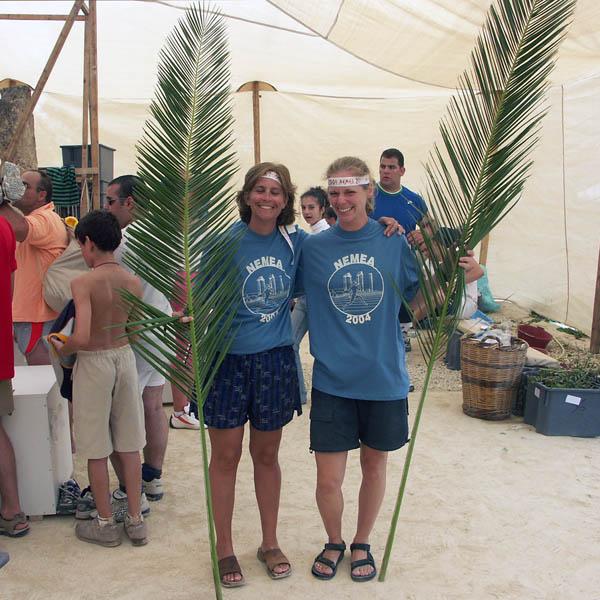
Two winners with ribbons and palm branches, but all the athletes receive a T-shirt.
Back inside the apodyterion a basin of water and a towel to wash off feet will be provided. The number/label will reclaim the bag with personal belongings from the doulos. Each runner will be presented with a special T-shirt with the emblem of the Nemean Games. to be worn for the duration of the games.
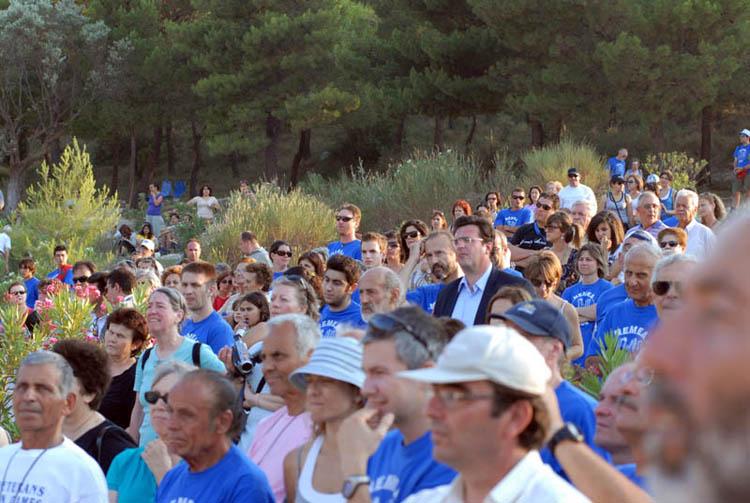
The crowd with the runners in their T-shirts.
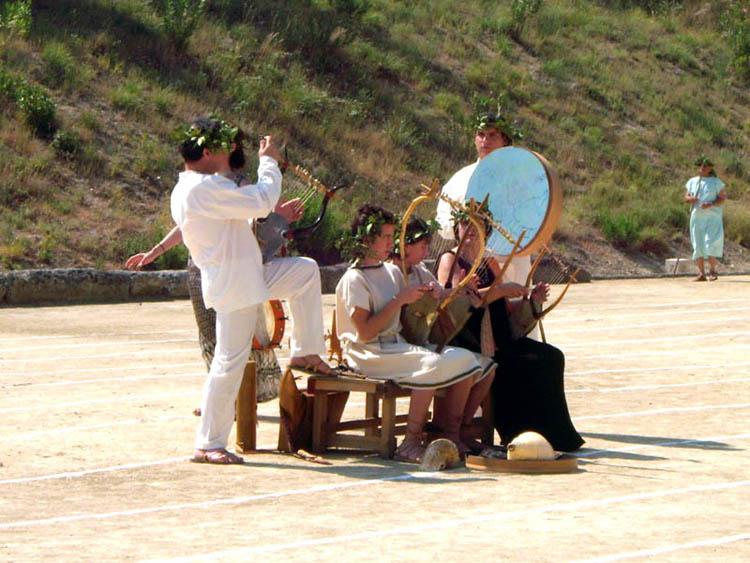
Performing ancient music.
Once clothed, the apodyterion is left behind and friends and family are re-joined on the earth embankments of the stadium. During the course of the games, and because it is necessary to have intermissions while the genders in the apodyterion are changed, performances by local amateur groups are offered and ancient music is performed for the enjoyment and edification of the audience.
In the afternoon those who are to run in the “Footsteps of Herakles” report to the apodyterion. The same procedures will be followed for clothing, except that it is permitted to keep shoes on. As the participants finish dressing in their chitons, they come out and board the bus that will take them to the ancient Temple of Herakles at Kleonai where they swear the Oath of the Games.
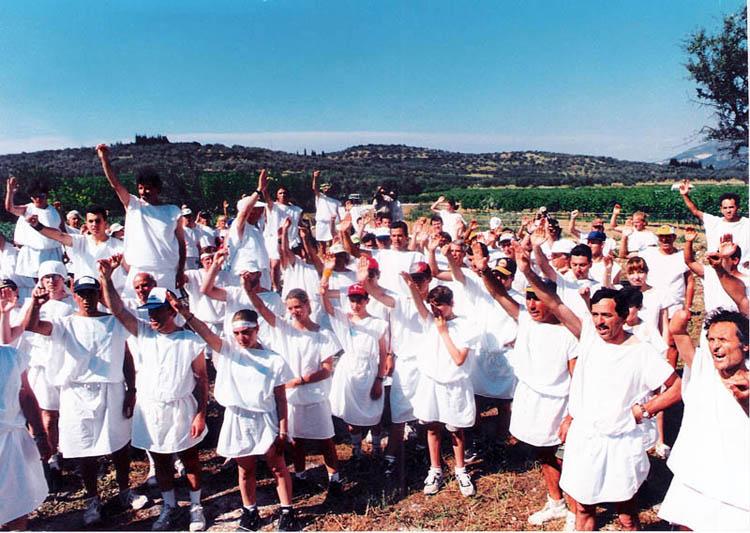
Swearing oath at the Temple of Herakles.
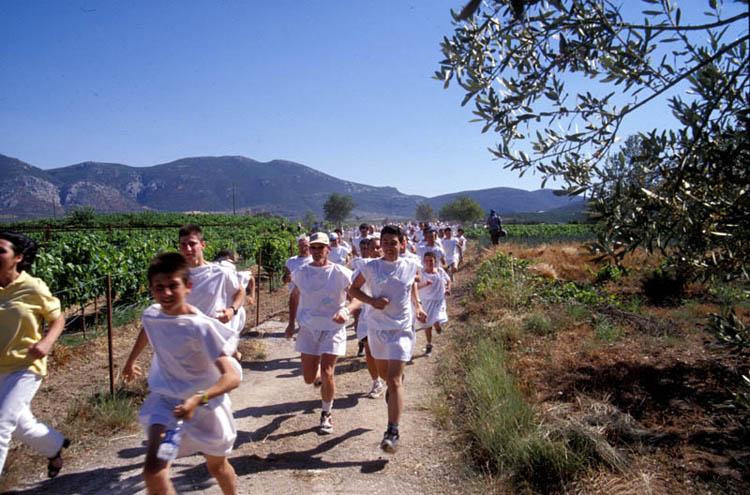
Running through the fields.
The first of the twelve Labors of Herakles was to slay the Nemean Lion, a beast whose skin could not be penetrated. Herakles was forced to wrestle the Lion and strangle him. Ancient authors tell that Herakles had his base of operations against the Nemean Lion at Kleonai. The modern race which follows the road from Kleonai to Nemea — as did Herakles — is therefore called “The Footsteps of Herakles”.
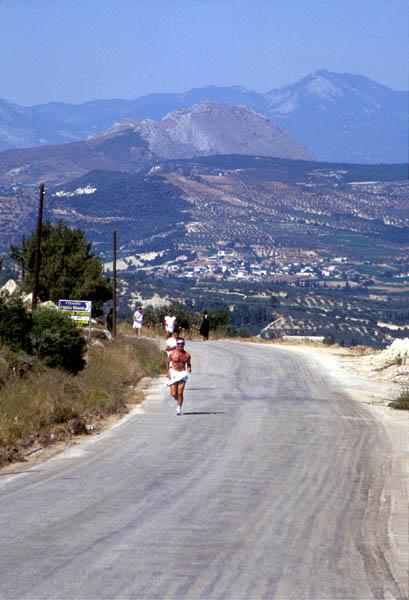
Akrokorinth looms over the
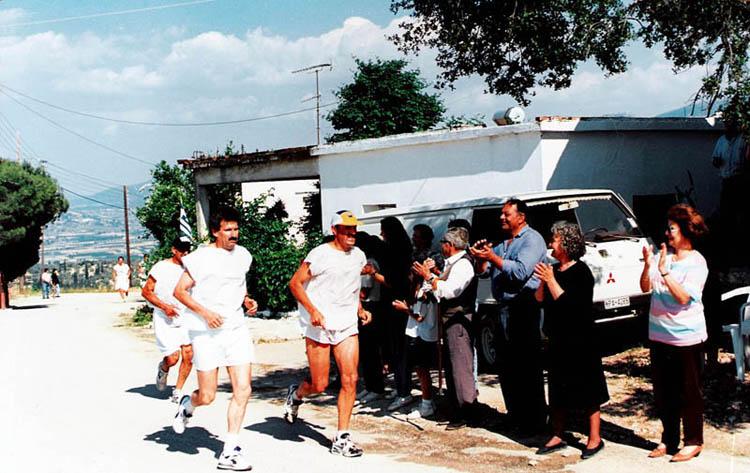
. . . . runners as they pass the last houses of Ancient Kleonai.
The course of the 7.5 km. race is marked clearly by a Hellanodikes and a doulos at each cross road. It begins from the Temple of Herakles and follows a country road through fields of grain, olive groves, and vineyards. The gradual uphill course becomes much steeper as the road enters and passes through the modern village of Kleonai with Akrokorinthos in the background.
Once beyond the last house of the village, the upward incline is more gradual, and on the left can be seen the cuttings in the bedrock where the blocks for the Temple of Zeus at Nemea were quarried about 330 B.C. Shortly after the ancient quarries, the crest of the ridge is reached, and a gradual downhill slope takes one beyond a crossroads in the form of a T.
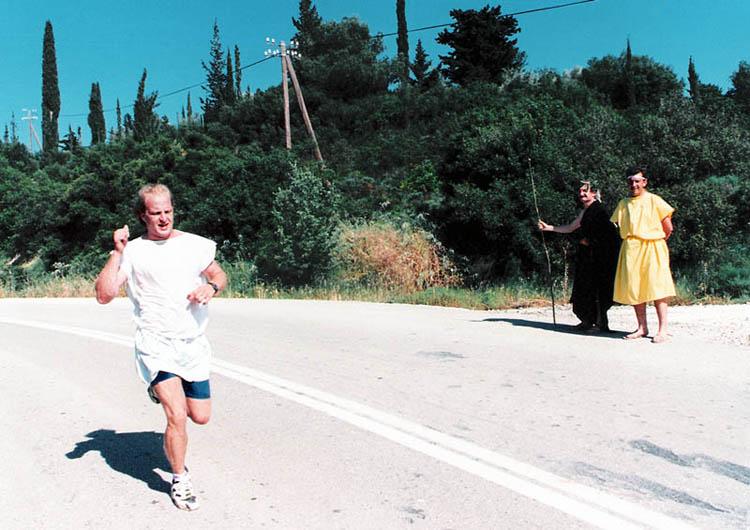
Past the road markers – judge and slave.
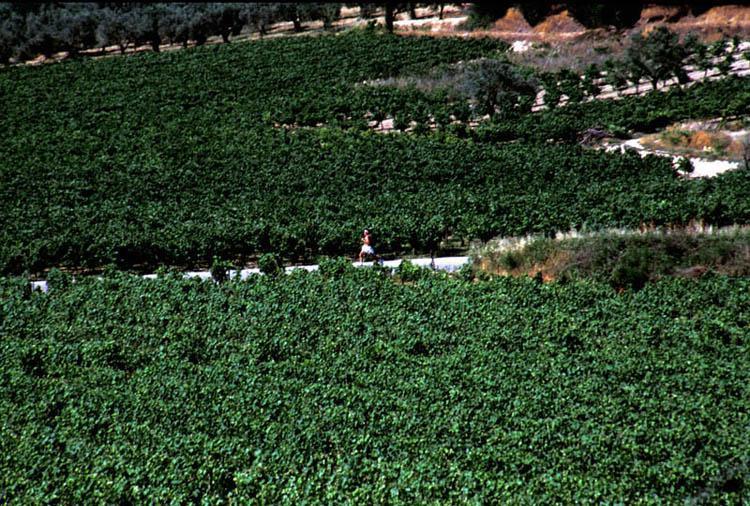
Running through the vineyards.
The road winds past a house on the left, through a narrow defile filled with cypress trees, and then comes out into the valley of Archaia Nemea. The Temple of Zeus will be visible in the distance, and as the downward slope increases, an ancient spring is passed on the right. It was called Adrasteia in honor of the leader of the Seven Champions who stopped at Nemea on their way to Thebes, and founded the Nemean Games after the death of the baby Opheltes.
A few meters beyond the fountain is the cemetery of the modern village; at a distance to the left is the ancient stadium — the end of the race. The road continues around beyond the stadium so that the participants run back into the entrance and to the apodyterion. Shoes will be removed in the apodyterion in order to run on through the tunnel barefoot. The competitors now run through the krypte esodos onto the track, turn left, round the Altar, and run back up to finish at the balbis.
After the last of the Footsteps of Herakles runners crosses the finish line, the participants return to the apodyterion to clean up and dress, and receive their T-shirt.
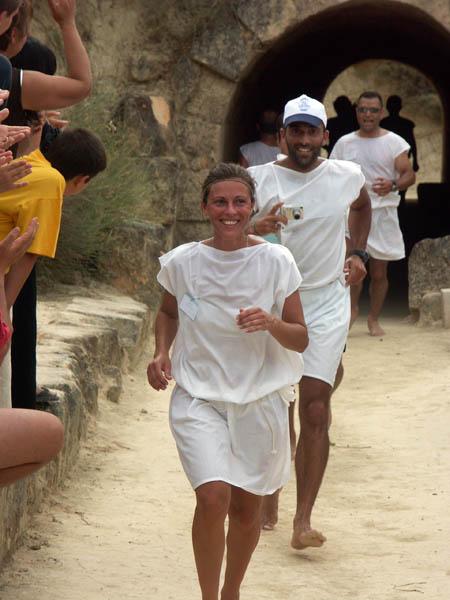
Barefoot through the tunnel . . .
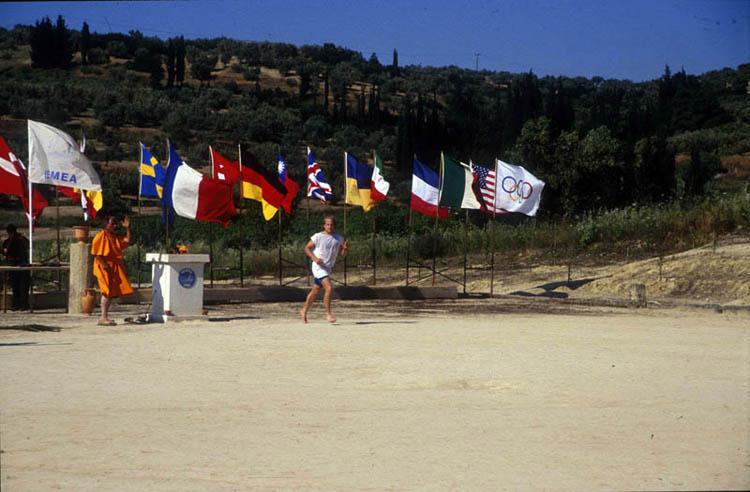
. . . and around the altar in front of the flags of the participants.
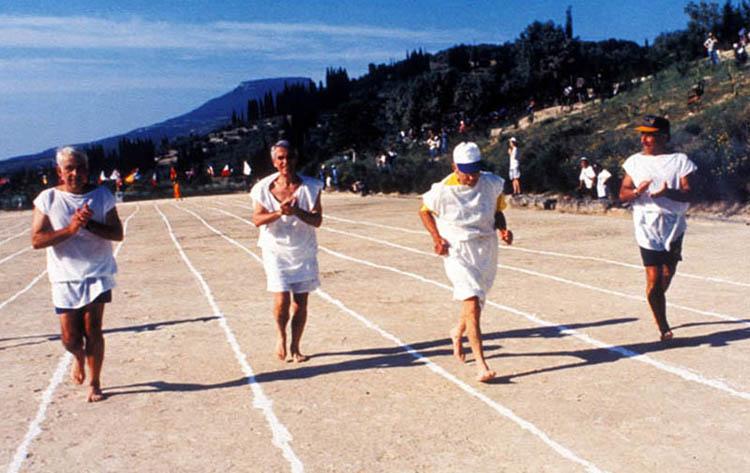
To the finish line – 88 year-old LaGrand Nielsen with honor guard.
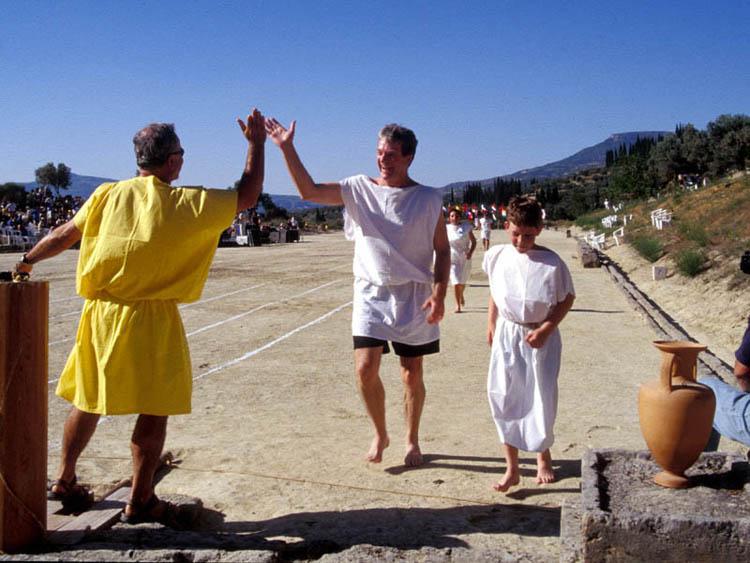
Canadian Ambassador David Hutton and son.
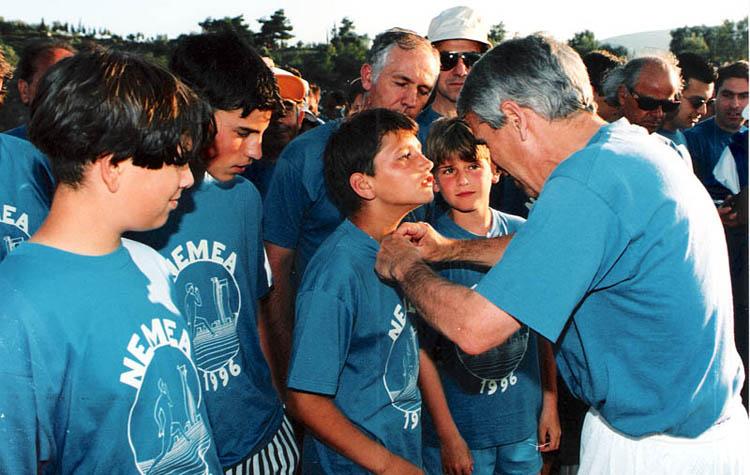
U.S. Ambassador Tom Niles
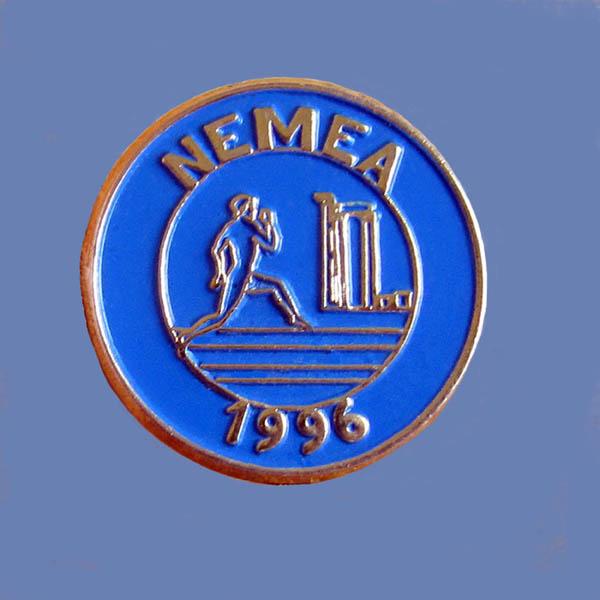
The pin of the Games.
Late that afternoon come the closing ceremonies. The winners, with their ribbons and palm branches, assemble in the apodyterion. All the other participants, clad in their T-shirts, assemble at the north end of the track in front of the Altar of Zeus and then file past the Hellanodikaion to receive a “Nemea” pin. This pin is not only the official badge of participation at the Games, but is also the “ticket” to the banquet that will follow for those who ran in the Nemean Games. Meanwhile the winners will be ordered in accordance with the sequence of races in the krypte esodos. When the keryx calls each name, he or she will come forward to the Hellanodikaion (judges’ stand) to receive the official ancient victory prize — the crown of wild celery. Meanwhile, the crowd showers the victors with flowers – the equivalent of the ancient “leaf-throwing” (phyllobolia) which occurred during the victor’s victory lap around the stadium at Olympia.
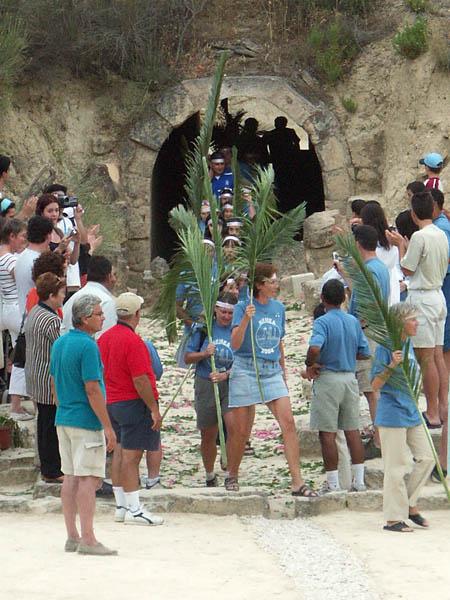
Victors enter the stadium, showered with flowers.
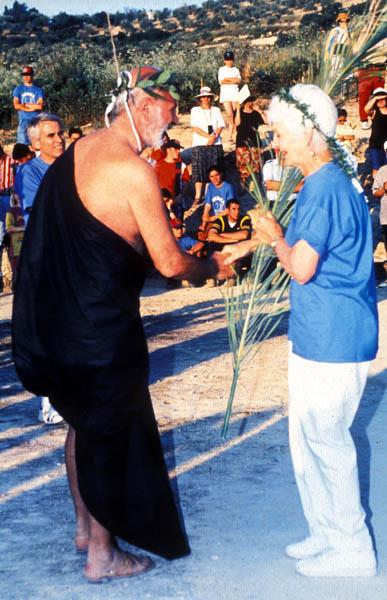
Judge crowns victor with wild celery crown.
With all the participants on the ancient track, the final ceremonies of the modern Nemean Games end with a prayer to Nemean Earth and the extinguishing of the flame on the Altar.
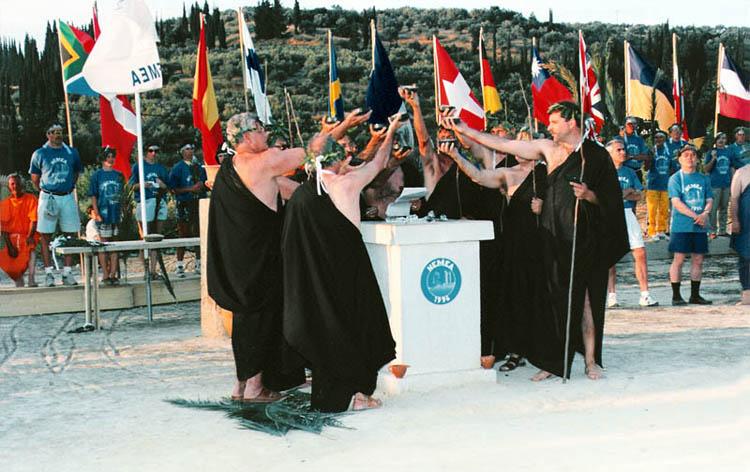
Extinguishing the flame of the games with the earth of Nemea.
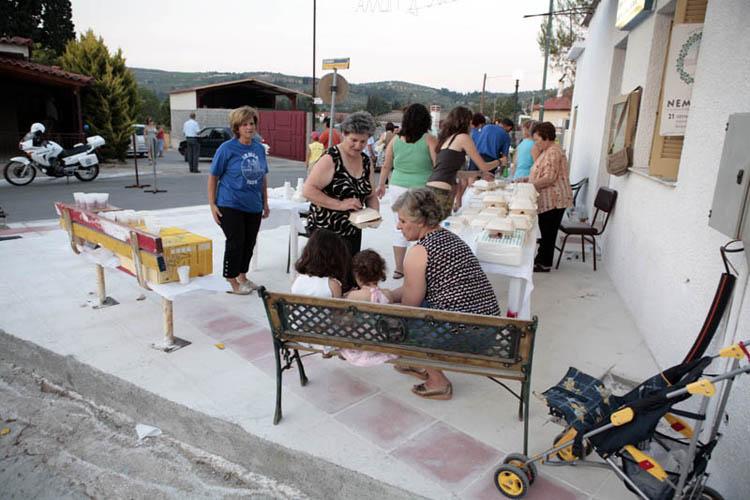
The women of Nemea preparing the banquet at the end of the Games.
The women of Nemea preparing the banquet at the end of the Games.